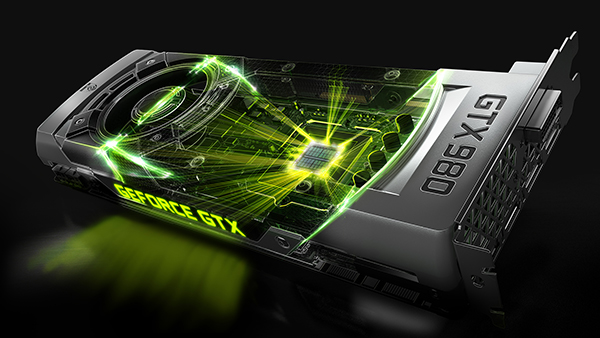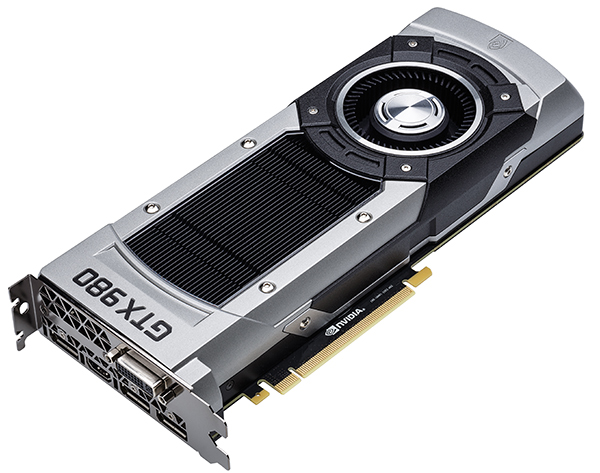Index
- Nvidia GTX 980 reviewed
- The GM204 GPU
- VXGI, dynamic global illumination technique
- MFAA, multi-frame sampled anti-aliasing
- DSR, dynamic super resolution
- A closer look at GTX 980
- Testbed
- 3DMark
- Sleeping Dogs
- Crysis 3
- Thief
- Battlefield 4
- BioShock
- Tomb Raider
- Far Cry 3
- Unigine Heaven
- Thermals and Noise
- Power Consumption
- Conclusion
- All Pages


Review: Pinnacle of efficiency
Nvidia has released two new graphics cards based on its latest Maxwell GPU architecture. The Geforce GTX 970 and Geforce GTX 980 will replace the outgoing Kepler-based Geforce GTX 780 and Geforce GTX 780Ti.
Nvidia designed Maxwell to deliver a twofold increase in performance-per-watt. This is very good news since it indicates a big improvement in efficiency and performance. On a side note, Maxwell is Nvidia’s tenth GPU generation, so some celebrations are in order.
With the GTX 980 and GTX 970, Nvidia also decided to launch a few new technologies there were not employed in the first incarnation of Maxwell on the GTX 750 series. Voxel Global Illumination, Multi Frame Anti-aliasing and Dynamic Super Resolution are the new technologies in question. They are built around old concepts, but they do a good job at reinventing them and we will take a closer look at each one of them later in our review.
Of course, the GTX 980 and GTX 970 are not the first cards based on the Maxwell architecture. Earlier this year Nvidia introduced the Geforce GTX 750 Ti, an entry level card with good performance and extremely low power consumption. At just 55W, the GTX 750 Ti is capable of delivering 1080p gaming. Several partners decided to launch low-profile versions of GTX 750 Ti, making it a very potent graphics card for small form factor rigs.
The GTX 980 and GTX 970 need quite a bit more power, but they are still vastly more efficient than their Kepler-based predecessors. The GTX 980 has a TDP of 165W, while the GTX 970 is rated at 145W. The old GTX 780 Ti and GTX 780 have a TDP of 250W.
What’s more, the GTX 980 and GTX 970 should be on a par with the GTX 780 Ti and GTX 780 respectively. Both cards are capable of delivering smooth frame rates at resolutions up to 2560x1600. In case you are planning to build a 4K capable system, two cards should be enough for good frame rates and anti-aliasing in demanding titles.
Both cards are based on the same GM204 GPU, manufactured on TSMC’s venerable 28nm process. The GPU packs 5.2 billion transistors and has a die size of 398mm2. The GTX 980 comes with 2048 CUDA cores, while the GTX 970 has 1664 CUDA cores enabled.
The base GPU clock of the reference GTX 980 graphics card is set at 1126MHz while the Boost clock is set at 1216MHz. The reference GTX 980 features 4GB of GDDR5 memory clocked at 1750MHz (7000MHz effective), providing up to 224GB/sec of peak memory bandwidth.
The GTX 980 cooler resembles the GTX 780 series cooler facing from the front, but once the card is turned it is easy to spot the difference – Nvidia decided to place a new backplate and I/O panel. The card sports a total of five display outputs, DVI-I, HDMI 2.0 and three DisplayPort 1.2 ports.

An important new feature (at least for gamers who want to show off on social networks) launched with GTX 780 cards in the form of ShadowPlay. This is an automatic gameplay recorder that uses GPU encoding and it ships with Geforce Experience 1.7 and higher. On the GTX 980, ShadowPlay supports 4K/UHD resolutions.
Shield PC streaming as well as G-Sync are supported as well. These features should help add a bit more appeal to GK110/GM204 based graphics cards. G-Sync can synchronize GeForce Kepler/Maxwell cards and your G-Sync capable monitors. This technology will eliminate frame stuttering and tearing due to a lack of synchronization between your graphics card and monitor. The Geforce GTX 980 also features the same GPU Boost 2.0 technology used in the Geforce GTX Titan, with more advanced controls for auto-overclocking, fan control, and hardware monitoring.
Of course, DirectX 12 is supported on all Maxwell cards.



